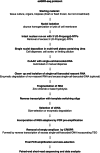Single-cell nascent RNA sequencing unveils coordinated global transcription
- PMID: 38839954
- PMCID: PMC11222150
- DOI: 10.1038/s41586-024-07517-7
Single-cell nascent RNA sequencing unveils coordinated global transcription
Abstract
Transcription is the primary regulatory step in gene expression. Divergent transcription initiation from promoters and enhancers produces stable RNAs from genes and unstable RNAs from enhancers1,2. Nascent RNA capture and sequencing assays simultaneously measure gene and enhancer activity in cell populations3. However, fundamental questions about the temporal regulation of transcription and enhancer-gene coordination remain unanswered, primarily because of the absence of a single-cell perspective on active transcription. In this study, we present scGRO-seq-a new single-cell nascent RNA sequencing assay that uses click chemistry-and unveil coordinated transcription throughout the genome. We demonstrate the episodic nature of transcription and the co-transcription of functionally related genes. scGRO-seq can estimate burst size and frequency by directly quantifying transcribing RNA polymerases in individual cells and can leverage replication-dependent non-polyadenylated histone gene transcription to elucidate cell cycle dynamics. The single-nucleotide spatial and temporal resolution of scGRO-seq enables the identification of networks of enhancers and genes. Our results suggest that the bursting of transcription at super-enhancers precedes bursting from associated genes. By imparting insights into the dynamic nature of global transcription and the origin and propagation of transcription signals, we demonstrate the ability of scGRO-seq to investigate the mechanisms of transcription regulation and the role of enhancers in gene expression.
© 2024. The Author(s).
Conflict of interest statement
US patent number US-11519027-B2 on ‘Single-cell RNA sequencing using click-chemistry’ was granted on 6 December 2022 to the Massachusetts Institute of Technology, Cambridge, MA, USA, on which P.A.S. and D.B.M. are named inventors. The other authors declare no competing interests.
Figures















Update of
-
Single-cell nascent RNA sequencing using click-chemistry unveils coordinated transcription.bioRxiv [Preprint]. 2023 Sep 19:2023.09.15.558015. doi: 10.1101/2023.09.15.558015. bioRxiv. 2023. Update in: Nature. 2024 Jul;631(8019):216-223. doi: 10.1038/s41586-024-07517-7. PMID: 37745427 Free PMC article. Updated. Preprint.
References
MeSH terms
Substances
Grants and funding
LinkOut - more resources
Full Text Sources
Molecular Biology Databases

